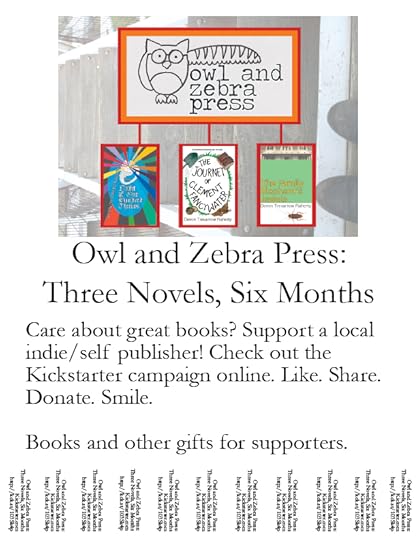Devon Trevarrow Flaherty's Blog, page 66
November 3, 2014
Self, Indie, or Artisanal?
I have to admit, I sort of annoy myself sometimes with all this hyphenate self-indie-artisanal publishing thing. I mean, which is it?
Of course, the main problem here is that that the publishing world is quickly shifting, and that lots of this is new. So one person might call something one thing, and another, another. And there’s plenty of heat around the terminology. Presses have been going by the term “indie,” for years, and many of them don’t really want to be lumped with or confused with this new batch of wildfire self publishers. Who can blame them, really? But the new POD self publishers–the ones doing a great job at it and embracing the positives of going rogue–don’t all want to be termed self-publishers either, because they feel it doesn’t reflect the quality of their work, their distinction from vanity press authors, and their spirit of entrepreneurship. Who can blame them either?
Let’s do our best to define some terms.
Self publishing – “The publication of any book or other media by the author of the work, without the involvement of an established third-party publisher …. The author is responsible and in control of [the] entire process including, in the case of a book, the design of the cover and interior, formats, price, distribution, marketing and public relations. The authors can do it all themselves or outsource all or part of the process to companies that offer these services.” (Thanks, Wikipedia.) Self publishing is broken down into three categories: ebooks, vanity publishing, and print on demand.
Indie publishing – (Also seen, less often, as indy publishing.) “Traditionally refers to independent art… created outside of the mainstream and without corporate financing. Although many independent book publishing companies are incorporated, they are independent of the major conglomerates that dominate the book publishing industry. Independent book publishers include small presses, mid-size independent publishers, university presses, e-book publishers, and self-published authors.” (Thanks IBPPG, ibppg.com.)
Small presses – A publisher with annual sales below $50 million or an average of less than ten titles per year. Is often used to refer to indie publishers. Practically, self publishers are often excluded from competing with “small presses,” when institutions require that the press publish more than one author’s work (like in contests).
Artisanal publishing – The term Apple’s Guy Kawasaki (and author of APE: Author, Publisher, Entrepreneur) uses to replace the stigmatized “self publishing.” The idea is that we give respect to artisanal bakers because they hand-craft and carefully labor, so why not give the same respect to authors who do that same thing?
Self printing – The term Self-Printed author and self-pub guru Catherin Ryan Howard uses to better define self-publishing. (She also uses the term self-publishing, because that is familiar.) It emphasizes the act of going out of house for printing only.
Well, that clears it up, doesn’t it? Sure, on paper, but not with people’s tempers or prejudices. Or perhaps it’s not completely prejudices, but ways people have of communicating with other people exactly what it is they do and what they don’t do, and in the most flattering light. And mechanisms for functioning, like for example, book contests that have been operating at a total submission rate of around 2000 for years claim they can not possibly expand quickly enough to accept self publishers. (And then that’s when the prejudices come in, as many of these same organizations shrug it off, saying “good riddance. Nothing good comes from Nazareth, anyways.”) We’ll just have to celebrate the rise of self pub contests, journals, and lists, then, and look for new ways to legitimize our work outside of the old standards.
At any rate, it looks like I am well within my bounds to call myself a self publisher, an indie publisher, an artisanal publisher, or self printed, and be right every time. I like the idea of artisanal publisher, but since it is rarely used, I think I’m going to stick to a combo between self publisher and indie publisher, because yes, I publish books and no, I am not ashamed that I only do my own.
(For more about how one can have the gall to name a one-person company, see the previous blog on The Accidental Entrepreneur.)
__________
Want to celebrate self publishing? Support Owl and Zebra Press at our Kickstarter campaign, and do it in the NEXT TWO DAYS! Then share it!
__________
Whatever kind of publisher you want to call her, I want to introduce you to Laekan Zea Kemp, the author of the YA ebook, The Girl In Between. She is currently running a blog tour to celebrate her most recent publication, Book 2 of the series, The Boy In Her Dreams. Check it out.
Bryn Reyes is a real life sleeping beauty. Afflicted with Klein-Levin Syndrome, she suffers episodes of prolonged sleep that steal weeks, and sometimes even months, from her life. But unlike most KLS patients, she doesn’t spend each episode in a catatonic state or wake up with no recollection of the time she’s missed. Instead, Bryn spends half her life in an alternate reality made up of her memories. For Bryn, the past is a place, until one day a boy she’s never met before washes up on the illusory beach of her dreams with no memory of who he is.
But the appearance of this strange boy isn’t the only thing that’s changed. Bryn’s symptoms are worsening, her body weakening as she’s plagued by hallucinations even while awake. Her only hope of finding a cure is to undergo experimental treatment created by a German specialist. But when Dr. Banz reveals that he knows more about her strange symptoms than he originally let on, Bryn learns that the boy in her head might actually be the key to understanding what’s happening to her, and worse, that if she doesn’t find out his identity before it’s too late, they both may not survive.
Find this book on Goodreads, Amazon, Google Play, and Smashwords. You can currently download the ebook for free from Smashwords and Google Play!
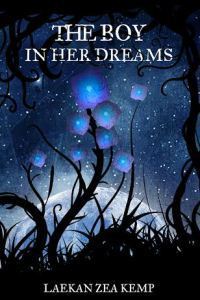 The Boy In Her Dreams (Book 2)
The Boy In Her Dreams (Book 2)
When Roman wakes from a six month coma, the first thing he sees is the girl of his dreams. Except Bryn isn’t confined to the dream-state anymore and neither is he. He’s awake and alive and as the memories of how he and Bryn fell in love come rushing back, so do the memories of why he’s lying in that hospital bed in the first place.
Plagued by guilt, Roman makes a decision that alters both their fates and as Bryn fights for her life in a German hospital, Roman must fight for her forgiveness before it’s too late. Because Roman and Bryn weren’t the only things to wake out of Bryn’s dreams. The shadows seem to be hunting them both and a strange side effect of Roman’s miraculous recovery may be the only means of stopping them. That is, if he can reach Bryn before she slips too deeply into the very dreams that seem to be imposing more and more on their waking lives every day.
Find Book 2 on Goodreads, Amazon, and Smashwords.
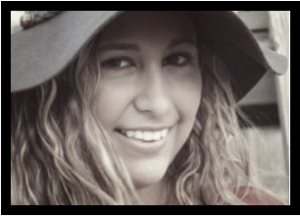 Laekan is a writer and explorer extraordinaire who grew up in the flatlands of West Texas. She graduated from Texas Tech with a BA in Creative Writing and is the author of the multi-cultural New Adult novels The Things They Didn’t Bury, Orphans of Paradise, Breathing Ghosts, and the Young Adult novel The Girl In Between, which is the first in an upcoming paranormal romance series.
Laekan is a writer and explorer extraordinaire who grew up in the flatlands of West Texas. She graduated from Texas Tech with a BA in Creative Writing and is the author of the multi-cultural New Adult novels The Things They Didn’t Bury, Orphans of Paradise, Breathing Ghosts, and the Young Adult novel The Girl In Between, which is the first in an upcoming paranormal romance series.
Find Laekan online at her blog, on Twitter, at Goodreads, and on Wattpad (free books!).


October 30, 2014
The (Sort of) Myth of Free Publishing
I have had many conversations with people attempting to inform the public about the vast changes that have happened (and continue to happen) in the writing and publishing world. I know the average Joe isn’t going to tolerate too much info or too specific news, but the field is just not what most people think it is. If you have not been in this conversation with someone, you may want to catch up HERE.
So then, you know that I have said many times before, self publishing is no longer vanity presses (unless, that is, you want it to be, and you actually pay for a vanity press. Not that we ever liked the term “vanity press,” anyhow. It’s sort of cruel and myopic, but you get the point). And since self publishing (otherwise known as indie publishing or artisinal publishing) relies so heavily on ebooks and PODs (print on demands), it is now free.
 Has any one ever told you that nothing is free? Of course they have. Have I told you that? Yes, I have. Then I went and had a Kickstarter campaign asking for money? Say what?!? Let me justify my hypocritical position.
Has any one ever told you that nothing is free? Of course they have. Have I told you that? Yes, I have. Then I went and had a Kickstarter campaign asking for money? Say what?!? Let me justify my hypocritical position.
And let’s break this down three ways.
 First, there is a reality where you can, officially, publish for free. You can write a book, upload it on the computer, publish it virtually, and send it to distributors. You can even do this with paperbacks (although illustrated books like cook books and picture books have a more complicated story). You take the ISBN from the distributor, you make your own cover, do your own editing, go for the “poor man’s copyright” and mail the manuscript to yourself… and your book is on Amazon’s bookshelf for free!
First, there is a reality where you can, officially, publish for free. You can write a book, upload it on the computer, publish it virtually, and send it to distributors. You can even do this with paperbacks (although illustrated books like cook books and picture books have a more complicated story). You take the ISBN from the distributor, you make your own cover, do your own editing, go for the “poor man’s copyright” and mail the manuscript to yourself… and your book is on Amazon’s bookshelf for free!
Second, the reality is that any book (even the one imagined directly above) is going to “cost” at least three things: tools, time, and ideas. In that sense, a book can never be quite free to publish. Which is why it is important, even in the age of easy publishing (and lots of inferior product to go along with it), that we recognize the work, sacrifice, and blood that goes into any good book. You can’t do free publishing without a computer and internet. You can’t do it without carving time (and sometimes lots of it) from your already crowded life. The product is your ideas. In some sense, those already have value. In the capitalist sense, they are still working on earning their value. So sure, the cost is literally free, but we know your resources, talent, and time are money.
Third, free publishing can only go so far, but affordable publishing can take you all the way.
 Crunching the numbers for my Kickstarter bid, I figured that for me to do a professional job publishing one of my own novels, in 2014, is around $3,000-$4,000 a pop. (And I’m not talking handing over the reigns to a vanity press. I am not a fan.) Using ebooks and PODs in the strongest way possible, you need some money, and you need it up front. Of course, your trade-offs for coming by that money yourself as opposed to taking a royalty from a traditional publishing company, are many. (For example, you gain creative control, speed of production, no need to spend years in rejection or shelve ideas you love, your work retains elasticity and longevity, etc. And let’s keep in mind you were always going to have to do your own leg work with publicity and sales.) But the result is more becoming of, say, adopting the title “indie publisher” or “artisinal publisher.” Not that you have to provide a paperback and a government copyright… it depends on your goal. My goal is a polished product with maximum distribution, and so much more.
Crunching the numbers for my Kickstarter bid, I figured that for me to do a professional job publishing one of my own novels, in 2014, is around $3,000-$4,000 a pop. (And I’m not talking handing over the reigns to a vanity press. I am not a fan.) Using ebooks and PODs in the strongest way possible, you need some money, and you need it up front. Of course, your trade-offs for coming by that money yourself as opposed to taking a royalty from a traditional publishing company, are many. (For example, you gain creative control, speed of production, no need to spend years in rejection or shelve ideas you love, your work retains elasticity and longevity, etc. And let’s keep in mind you were always going to have to do your own leg work with publicity and sales.) But the result is more becoming of, say, adopting the title “indie publisher” or “artisinal publisher.” Not that you have to provide a paperback and a government copyright… it depends on your goal. My goal is a polished product with maximum distribution, and so much more.
Here is the way I have broken down the costs for professionally self/indie publishing a novel in 2014, with approximate costs. (I left out taxes, fees, and gifts):
Costs Per Book
ISBNs, $200
Copyright application, $50
Ink, $100
Paper, $25
Stock, $230
Proofs, $60
Beta Reader Copies*, $50
Contest entry fees*, $400
Reviews (free and paid)*, $700
Local news copies*, $30
Advance Reader Copies*, $330
Fliers, $50
Launch costs, $330
Local bookstore copies, $100
Padded envelopes, $150
Publishing Operational Costs (per year)
Writing membership dues, $120
Trade magazine subscriptions, $250
Publishing software (by subscription), $480
PO Box, $60
Website domains, $60
Trade materials and book budget, $200
Business cards, $50
Tool repair and upkeep, varies widely year to year, from almost nothing to thousands of dollars
*Includes shipping.
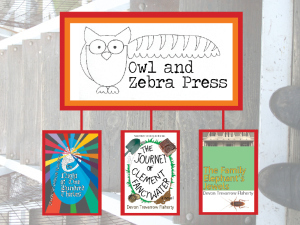 So what justifies these expenses? I’m not going to do a whole lot of convincing in one paragraph–and I have read several books about this–but I think I can give you a few reasons that might let you know which way you want to self publish. Or why you should support Owl and Zebra Press’s Kickstarter bid. Number one, professionalism. Number two, rights. Number three, sales. Basically, if my costs aren’t directly affecting one of those three, I cut them. But I feel that in order to have the most competitive, copyright safe, and profitable self-published book, I need $3,000-$4,000 each time. In the future, I expect all this investment and hard work to pay off, and each former book will pay for the future book plus a salary. Until then…
So what justifies these expenses? I’m not going to do a whole lot of convincing in one paragraph–and I have read several books about this–but I think I can give you a few reasons that might let you know which way you want to self publish. Or why you should support Owl and Zebra Press’s Kickstarter bid. Number one, professionalism. Number two, rights. Number three, sales. Basically, if my costs aren’t directly affecting one of those three, I cut them. But I feel that in order to have the most competitive, copyright safe, and profitable self-published book, I need $3,000-$4,000 each time. In the future, I expect all this investment and hard work to pay off, and each former book will pay for the future book plus a salary. Until then…
Check out the Owl and Zebra Kickstarter bid HERE. And fund it, people! We are now in the final stages, where real funding happens. Let’s make it happen!


October 24, 2014
Welcome to the Self-Printed Splash
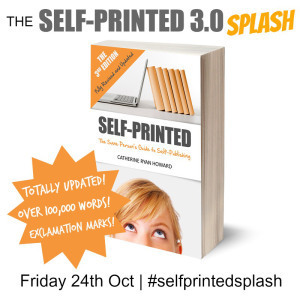 Yes, this is still the Starving Artist. And yes, Devon is still behind the wheel. Today, however, the Starving Artist is going to let someone else take the blog for a test drive. And believe me, you’re in great hands.
Yes, this is still the Starving Artist. And yes, Devon is still behind the wheel. Today, however, the Starving Artist is going to let someone else take the blog for a test drive. And believe me, you’re in great hands.
Catherine Ryan Howard is the author of Self-Printed. In my opinion, Self-Printed is the book on self(/indie/artisan) publishing. For one, Catherine is incredibly knowledgeable about this new and exciting world, and she walked me through my first publication in 2013. For two, she makes me laugh, which is really helpful when you are re-stripping your Word file for an epub for the third time and want to chuck your computer out the window. For three, she is no nonsense. If you are in la-la land or have some delusions about self publishing, she can help you either develop beyond them or get out of dodge. This is important stuff. Believe it.
If you have been considering self publishing, you are in luck, because Self-Printed version 3.0 is hitting the shelves. Things change fast in this field, so this is the best and newest info. I’m not saying you should stop with her book, but you definitely want to have it on your shelf. And read it. And highlight passages. And tag pages. And carry it around with you like a Home Ec flour baby.
Now here’s Catherine, answering the question I sent her about self publishing.
Q: How do you keep up with all the (ever-changing) indie pub information? How much time do you spend on it?
A: To answer this question, I’ll start by telling you that I know (this last weekend in August, when I’m writing this answer) that Brad and Angelina finally got married at the villa in France this week, and that Brad used to be with Jen who is now with Justin, and that Angelina was with Billy Bob and before that, Johnny Lee, and that their paths intercepted on the set of Mr. and Mrs. Smith and that Jen would subsequently accuse Brad of missing a “sensitivity chip” when he posed in a husband-and-wife photo spread with Angelina when the ink on the divorce papers was barely dry. I could also tell you, were I pushed, the names of all their children. (Maybe.) Why? Because I’m entertained by celebrity news. I like it. It would be my specialist subject on Mastermind. If they were offering PhDs in it, I’d have already earned mine. But do I have to consciously think about “keeping up” with it? Do I ever tell myself “Well, I better spend 2-3 hours on TMZ this week so I can keep on top of who’s walking out of a gym in full make-up and who’s walking out of a gym all red and sweaty?” No, I don’t. (I hope no one does!) I don’t because it is something that genuinely interests me and so without making a conscious effort, I am always on top of it.
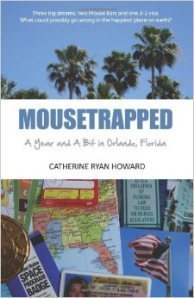 For me, it’s exactly the same with developments in the self-publishing world. I don’t make a conscious effort to stay on top of things because I have a genuine interest in them, so when I’m flicking casually through Twitter (the best source of info, in my opinion) and I spot a link I like, it isn’t a chore to go check it out. I don’t have to consciously think about it. I just go do it, because I want to.
For me, it’s exactly the same with developments in the self-publishing world. I don’t make a conscious effort to stay on top of things because I have a genuine interest in them, so when I’m flicking casually through Twitter (the best source of info, in my opinion) and I spot a link I like, it isn’t a chore to go check it out. I don’t have to consciously think about it. I just go do it, because I want to.
I suspect though you’re asking for the people who don’t necessarily find all of this fascinating. I would first say that if that’s the case, I have some concerns. Because if you’re a self-publisher, self-publishing is your business and to succeed at business you need to be passionate about it, and if you aren’t all that interested in self-publishing, then you’re hardly passionate about it, are you? But on the other hand, maybe it’s just an issue of time – you not having any, and yet you wanting to stay abreast of what’s new and exciting and relevant in the self-publishing world.
Well, for you I’d recommend finding a handful of blogs – say, maybe 5 of them – that are fountains of information. Of course I’m going to say my one (um, obviously!) but there’s also The Book Designer, The Creative Penn and others like them. If there’s something new and useful, you can rest assured they’ll be writing about it. Use a service like Feedly to bring the blogs to you and so save time and effort. Or you could subscribe to them by e-mail so every new post lands in your inbox. The companies you’ll use – CreateSpace, Amazon KDP and Smashwords – are also great for updating their users on any new features that are available, so make sure in your account settings that you’re signed up for those mailings. Finally I would say follow those same bloggers I mentioned on Twitter, because usually they retweet anything interesting that they come across on other blogs. This won’t take more than a few minutes a week – maybe half an hour of blog-reading time which you can do with a cup of coffee or on your phone during commercial breaks or while stuck in a line for something – and will ensure that you always know what’s new and exciting in the world of self-publishing.
______________________
 Catherine Ryan Howard is a writer, self-publisher and caffeine enthusiast from Cork, Ireland.
Catherine Ryan Howard is a writer, self-publisher and caffeine enthusiast from Cork, Ireland.  SELF-PRINTED: THE SANE PERSON’S GUIDE TO SELF-PUBLISHING (3rd edition) is out now in paperback and e-book and available from Amazon. Follow the #selfprintedsplash on Twitter today (Friday 24th) and/or visit www.catherineryanhoward.com for a chance to win an amazing prize that will get your self-publishing adventure started!
SELF-PRINTED: THE SANE PERSON’S GUIDE TO SELF-PUBLISHING (3rd edition) is out now in paperback and e-book and available from Amazon. Follow the #selfprintedsplash on Twitter today (Friday 24th) and/or visit www.catherineryanhoward.com for a chance to win an amazing prize that will get your self-publishing adventure started!
“SELF-PRINTED is my self-publishing bible. It taught me how to format, create and upload my e-books and print-on-demand paperbacks. It showed me practical things such as how to build a website/blog and how to promote my books. More importantly, it taught me how to compete with the professionals. Just look at the results – The Estate Series has sold nearly 100,000 copies and following that I got a traditional book deal with Thomas & Mercer too, so I’m now a hybrid author. Jam-packed full of hints and tips all in one place, I’m always referring back to it. In a word, it’s priceless.” – Mel Sherratt, author of The Estate Series and DS Allie Shenton Series


October 21, 2014
Services for Hire
This is an unconventional post. I’m not going to do a book review, a best books list, or even blab on and on about some fascinating aspect of writing or artisanal publishing. I am going to do something I do only once in a long while, and that is craft a post around an announcement. Usually, it means one of my books has just come out or is about to. This time, it means I am in the middle of a Kickstarter campaign (and if you didn’t know that, you haven’t visited in awhile). SEE HERE for Owl and Zebra Press: Three Novels, Six Months.
So here’s the pitch: I need publicity. I need my friends and followers to share with their friends and followers. Therefore, I am willing to reciprocate with other bloggers and website hosts for those things. I can guest blog, interview, offer a give away, or just appear. You just have to share about my Kickstarter campaign, encouraging others to go there and consider donating. (If you don’t have a blog, say, you can just share, share, share ;) ). If you are interested, just comment below, or email me at [email protected].
And here’s how you can get something from reading even this entry: Do you have a blog? You want more readers? More followers? The key is to read, comment, and ask.
Read other blogs. Search for ones that have similar topics and would attract the same audience you are looking for.
Comment on those blogs. Leave only real and sincere comments, but leave them often. Don’t try to sell anything in your comments.
Approach those bloggers (and others like them) with a friendly email, when you are willing to trade work for publicity. When I have a book coming out, I offer a free copy of the book for a review (but only at weblogs that state they are open to solicited reviews). At this time, I am offering to provide original content for them.
Fortunately or unfortunately, readers don’t just start flocking in when you begin a blog. But if you have something to say, something useful or inspirational, use other blogs and websites to build a network. It becomes a sort of spiderweb of connection and, on a day when you write a real stinker, you’ll be able to rebound.


Kick Start It
It’s funny how many times in the past week I’ve had this conversation:
Me: I’m doing a Kickstarter campaign.
Them: [blank look]
Me: You know what Kickstarter is?
Them: No. [apologetic look]
Me: [deep breath, settle in for slightly boring explanation] Do you know what crowdfunding is?
Them: Oh yeah! Kickstarter. I know it.
 Somehow, the word Kickstarter has not, among the average Joe, become synonymous with crowdfunding, like Google has for using a search engine or Kleenex has for facial tissues. And yet, everyone seems to be familiar with it when you remind them. Exactly how familiar, I’m not sure, since Kickstarter experts still suggest that you explain the Kickstarter process in your video and your literature. The number one misunderstanding? That the campaigner gets whatever funding is pledged, no matter how high or low.
Somehow, the word Kickstarter has not, among the average Joe, become synonymous with crowdfunding, like Google has for using a search engine or Kleenex has for facial tissues. And yet, everyone seems to be familiar with it when you remind them. Exactly how familiar, I’m not sure, since Kickstarter experts still suggest that you explain the Kickstarter process in your video and your literature. The number one misunderstanding? That the campaigner gets whatever funding is pledged, no matter how high or low.
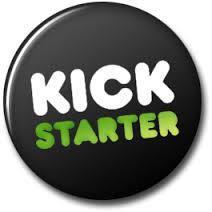 Kickstarter is “a global crowdfunding platform based in the United States.The company’s stated mission is to help bring creative projects to life” (Wikipedia; “creative” can be anything from architecture to food, dance to toys).
Kickstarter is “a global crowdfunding platform based in the United States.The company’s stated mission is to help bring creative projects to life” (Wikipedia; “creative” can be anything from architecture to food, dance to toys).
Crowdfunding “is the practice of funding a project or venture by raising monetary contributions from a large number of people, typically via the internet” (Wikpedia).
A Kickstarter campaign is an attempt by an individual or indie company to raise funds for a creative project, using Kickstarter.
So I thought I would help a brother or sister out. Here are some (slightly) interesting facts about a Kickstarter campaign, in no particular order:
Most money is raised at the end. For this reason, Kickstarter limits campaigns to 60 days and encourages less than 30. It is also the reason a campaign can look really under-funded until the last minute. Let’s hope that is what’s happening with my campaign, which is at 1-2% five days in.
Most funding comes from friends and friends-of-friends. This is a crowdfunding mantra. It means that your (hopefully giant) network is important. It also means you may have to send emails. It also means that the best thing your “friends” can do for you is share with their “friends.” Like with a smiley face and a nice recommendation.
The campaigner gets NO funding if the monetary goal is not met by the deadline. In other words, if I don’t have $17,579.00 pledged by Wednesday, November 5 at 11:00 p.m. EST/EDT, I don’t see a single penny and none of the pledgers gets charged a dime. It is all or nothing, which is Kickstarter’s way of ensuring that everyone’s donations count for something. The theory is, if it is not a fully funded project, it can’t be successful, and likely won’t even be completed. In a way, they are protecting the donors’ interests.
On the other hand, if the campaign exceeds its goal (by a little or even a way lot), the campaigner gets all the funds pledged. That’s why the campaign should mention what would happen to excess funds. My excess funds will go toward operational costs of the business and future publications.
Gifts! If you pledge more than the gift minimum (which is usually a small amount; mine is $5), you are eligible for a gift (meaning, it’s yours if the project is funded, but you can decline it). Gifts are distributed only if funding goals are met, and the expected time of delivery on the gift is listed right there with the gift. This is one of the more fun aspects of Kickstarter, and it can really help move a gift from, say, $10 to $25. My gifts include everything from ebooks and paperbacks to a catered party and naming a character after you. (In a smart campaign, gift redemption costs are included in the total funding needed.)
Fees and taxes apply. (In a smart campaign, fees and taxes are included in the total funding needed.) That also means that not every cent of your donation goes toward the project, but a majority of it does. Kickstarter takes 5% and the payment process takes another 2-5%. It’s pretty minimal, really. And then we all pay taxes on earnings, so…
The dollar amount reflects a real budget for a real project. You can’t just be like, “I need money for my business. Maybe $50,000 for the year?” Each Kickstarter campaign stands for a particular project with specific goals, deadlines, and a price tag. Personally, I have a list of over 30 dollar amounts that are direct costs of publication, printing, and publicizing the three novels by Owl and Zebra Press listed on the campaign (like sending copies to local news sources, $114, and proofs, 15 total with shipping, $180). With the funding, all three books can be shipped out in six months.
There are other crowdfunding companies. I don’t really know them. They have some benefits over Kickstarter, but also some limitations. Kickstarter seems to be the biggest and most popular.
There are no Kickstarter police. In theory, someone could win a Kickstarter bid and then make off with the money and never look back. Kickstarter relies on two things: 1) funding comes largely from people the campaigner knows; 2) the campaigner gets to sort of prove their reliability through their campaign. Owl and Zebra Press has published a book before. The Starving Artist has maintained a competitive blogsite for two years. Flaherty has a presence across the internet, from guest blogs to Goodreads. You can order her book at Barnes and Noble. The reviews are good. Etc.
44% of the campaigns are successful. That’s sort of good and bad news.
A campaign is a lot of hard work. Fulfilling a campaign is even harder. You have to hit the pavement, stay up late, talk when you’d rather hide, cry some… And then, if you get funded, you actually have to publish three books. But it is so worth it.
You can not write a check or slide some cash to the campaigner the next time you see them at church. I mean, you could, and they might appreciate it, but it won’t help them with their campaign. Your donation only counts toward the goal if it is donated online, on Kickstarter. Luckily, this process is pretty simple. If you can purchase something from Amazon, you can make a donation at Kickstarter.
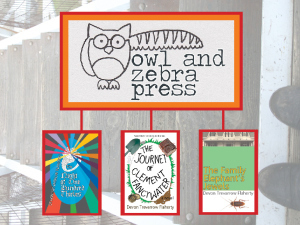 So that’s basically Kickstarter. And a little bit crowdfunding. People do Kickstarter campaigns because they have a creative project that they don’t think they can bring to fruition without financial backing. So they turn to the people. They say to the people, “Don’t you think this project is valuable? If so, be a part of making it happen!”
So that’s basically Kickstarter. And a little bit crowdfunding. People do Kickstarter campaigns because they have a creative project that they don’t think they can bring to fruition without financial backing. So they turn to the people. They say to the people, “Don’t you think this project is valuable? If so, be a part of making it happen!”
You want to see my next three novels on the bookstore shelves? I sure do. I think my books add value to people’s lives. I think they are enjoyable and even a bit emotionally instructive. They represent. So perhaps you should represent, right there on Kickstarter. Check out the project RIGHT HERE. And even if you don’t donate, please share, share, share!


October 17, 2014
The Dull Roar of Silence
 Well, I’m at it again. A couple of years ago, I was convinced that a Kickstarter bid for crowd-funding was exactly what I needed to finish my first novel (or, in this case, trilogy) and start getting it to agents. Just those couple of years later, everything has changed. I’m a die-hard self-publisher now, with my own publishing company, Owl and Zebra Press. In 2013, I published my novel, Benevolent, to good reviews, a hand-full of awards and book-front stickers, and lackluster sales. It takes time, they say. It might even take a backlist, they say. And more time.
Well, I’m at it again. A couple of years ago, I was convinced that a Kickstarter bid for crowd-funding was exactly what I needed to finish my first novel (or, in this case, trilogy) and start getting it to agents. Just those couple of years later, everything has changed. I’m a die-hard self-publisher now, with my own publishing company, Owl and Zebra Press. In 2013, I published my novel, Benevolent, to good reviews, a hand-full of awards and book-front stickers, and lackluster sales. It takes time, they say. It might even take a backlist, they say. And more time.
But how to get to that deep backlist?
I am sitting on a novel which is just weeks away from relative perfection. I’ve got the paperback proof in my hot little hands. And I have–thank goodness a year and a half weren’t unproductive–two more novels somewhere over half-way there. But I need to apply for a copyright. I need new publishing software. Blah blah blah. And I am once more drawn, so much like the proverbial moth and the flame, back to Kickstarter.
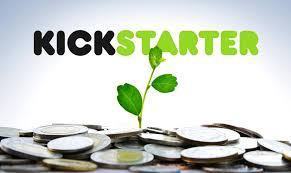 A couple years ago, my bid failed. Its problems ranged from a vague budget to a lack of tangible costs (like childcare). But really, the failure was a personal one. Things came up. (And by things, I mean end-of-life moments and double funerals.) Once the bid was launched, I never touched the thing, and even though there was a faint glimmer of hope that I would be the one bid that made it without trolling the internet for a month straight–I let it go. Some things are more important than funding. Some things are even more important than publishing that next book right now.
A couple years ago, my bid failed. Its problems ranged from a vague budget to a lack of tangible costs (like childcare). But really, the failure was a personal one. Things came up. (And by things, I mean end-of-life moments and double funerals.) Once the bid was launched, I never touched the thing, and even though there was a faint glimmer of hope that I would be the one bid that made it without trolling the internet for a month straight–I let it go. Some things are more important than funding. Some things are even more important than publishing that next book right now.
So I feel the ominousness of a Kickstarter campaign like a sourness in the gut. No one likes to fail. Let me rephrase that: I don’t like to fail, I don’t want to fail this time, and I didn’t enjoy it last time. It’s like a blot on my resume that I rarely get the opportunity to explain. Part of me says, “What do I have to lose?” I get the bid or I don’t. If I do, awesome. If I don’t, nothing has changed. Except a blow to my pride. Perhaps losing has its benefits, too.
I mean, let’s be honest. Kickstarter has a 44% success rate. That’s decent, but we’re not cashing any checks yet. I am going to be yelling about it from the roof tops for the next nineteen days. I have a pretty decent network (whereas last time I absolutely did not). However, winning a bid requires a little bit of that pixie dust that modern society requires for almost any success, especially in the arts. It just needs the right person, at the right time, in the right mood, with the right thing on their mind… There’s plenty of talent out there, mooshed with even more people ready to convince you they have talent or merit. How to rise above? Perspiration and pixie dust.
 I know I’m good for it. I know my books are professional. I have so much I want to say to the world, so many stories buzzing in my ribcage to get out, and a deep affinity for the written word. How do you put your blood in the bid? How do you get people to even click on it? Hopefully my smiling face and a catchy title will do it.
I know I’m good for it. I know my books are professional. I have so much I want to say to the world, so many stories buzzing in my ribcage to get out, and a deep affinity for the written word. How do you put your blood in the bid? How do you get people to even click on it? Hopefully my smiling face and a catchy title will do it.
So this post, of course, isn’t really about Kickstarter or crowd-funding; we’ll get to that in the next few weeks. It’s about, whuddya know, the dull roar of silence; the heaviness of the quiet after a joke; the raised eyebrows when you sashay into a room in that new dress; the crickets you hear after the modern publishing date. And it’s about (seems like my favorite topic) the grit it takes to be an author. In six months and three weeks from now I will be doing one of two things: chatting bulk shipping with my local mailman and sending packages of three paperbacks as gifts to funders while writing; or writing. Either way, the stories keep pushing outward and I keep humoring them. For better or for worse.
_______________
(For the vlog (video version) of this post, please visit the Starving Artist on Youtube.)


October 16, 2014
Holiday: A Very Harry Month
 I lurve me some Halloween. I’m not big on the grody stuff, like vampires and tombstones. What I love is dressing up, the fall weather, carving pumpkins, caramel apples, candles flickering, and neighborhood kids running around in the night. What I also love is re-reading Harry Potter.
I lurve me some Halloween. I’m not big on the grody stuff, like vampires and tombstones. What I love is dressing up, the fall weather, carving pumpkins, caramel apples, candles flickering, and neighborhood kids running around in the night. What I also love is re-reading Harry Potter.
 There are two series of books I try to re-read every year. Both of them I enjoy immensely for their ability to take me on a vacay of the mind. I also learn from them. From Harry, I learn lots about plotting, suspense, carrying a plot point through, staying consistent with character, and, dang it, hooking readers. These are not my natural strong points. I am more of, how do you say it nicely?, a lyrical writer. So, while my GoodReads Reading Challenge 2014 and my TBR sit idle, I have lost myself, once again, in Hogwarts.
There are two series of books I try to re-read every year. Both of them I enjoy immensely for their ability to take me on a vacay of the mind. I also learn from them. From Harry, I learn lots about plotting, suspense, carrying a plot point through, staying consistent with character, and, dang it, hooking readers. These are not my natural strong points. I am more of, how do you say it nicely?, a lyrical writer. So, while my GoodReads Reading Challenge 2014 and my TBR sit idle, I have lost myself, once again, in Hogwarts.
Here are other things I love about Halloween time (which, let’s face it, is the whole month of October):
 our Halloween buffet, which in the past has revolved around chili, mummies in a blanket, or a giant bratwurst sub, but always includes some Butterbeer and bone cookies.
our Halloween buffet, which in the past has revolved around chili, mummies in a blanket, or a giant bratwurst sub, but always includes some Butterbeer and bone cookies.October snacking, like caramel apples, sugar-cinnamon donuts, roasted pumpkin seeds, caramel corn, mulled cider, monster mouths, and pumpkin chip cookies. Not to mention all the other Oktoberfest eating, like roasted chicken, kraut, schnitzel, pretzels, and spaetzel. And fancy beer and imported mustard.
 cider mills. Oh yeah, they don’t have those properly in the South. Ah well, there is a fairly Northernesque one in Ramseur, NC. As for the northerners out there, I know you love you some hayride, some cold, fresh-pressed cider, hot donuts, long lines, and swarms of bees.
cider mills. Oh yeah, they don’t have those properly in the South. Ah well, there is a fairly Northernesque one in Ramseur, NC. As for the northerners out there, I know you love you some hayride, some cold, fresh-pressed cider, hot donuts, long lines, and swarms of bees.bonfires. I have such fond memories of late nights huddled around bonfires against the encroaching freeze. Love the way the cold makes the nights clearer. Love the smell of burning wood and the jump of the flames.
fall camping and hiking. Where’s the kill-joy who doesn’t like the explosion of colors the fall brings to nature? Or the pure scent of it?
family costumes. I know it won’t last forever, but our kids are still in a stage where they let us plan our costume together. Starting with, appropriately, Harry Potter (Harry, Hermione, Head Boy, and Head Girl), we have been through Word Girl (Word Girl, Captain Huggy Face, Lady Redundant Woman, Doctor Two Brains), DC Comics (Bat Man, Bat Girl, Cat Woman, and Robin), and Scooby Doo (Fred, Velma, Daphne, Shaggy). This year… Phineas and Ferb (and Candace and Isabella)!



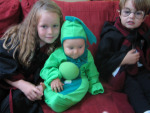
decorating and carving pumpkins, and filling the house with candles. I’m always waiting for the next excuse to string some lights and break out the appropriately-scented candles.
The Nightmare Before Christmas (movie). Perfect for the day after Halloween, sandwiched right between the holidays that it features. It might even get you in the mood for Christmas. Not really recommended for small kids, but I really enjoy Tim Burton’s endless imagination and slightly creepy vibe. You could also go with Coraline or The Corpse Bride.
Cloverfield (movie). You want a real scary movie? I don’t do them. But between M. Night Shyamalan and J.J. Abrams, I can get the willies without them. (Extend to The Sixth Sense, Super 8, Unbreakable, and Signs.)
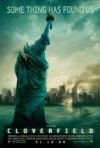 Frankenstein (book). Classic. Not the movie, the book. Reading this for the first time as an adult, I was very pleasantly surprised. It’s a quick read for the time period, and it’s pretty darn meaningful besides.
Frankenstein (book). Classic. Not the movie, the book. Reading this for the first time as an adult, I was very pleasantly surprised. It’s a quick read for the time period, and it’s pretty darn meaningful besides.The Ghost Eye Tree (book). That would be for the kids. It’s a picture book. Extend to almost anything Chris Van Allsburg.
It’s the Great Pumpkin, Charlie Brown. For all of us. This is one of my favorites, probably because of the nostalgia, but that’s how the world turns, right?
The Witches (book). Roald Dahl. I know I said I didn’t do witches, but I am a Dahl fan. Too scary for my fantasy-oriented kids. Extend to other Dahl books and some movie adaptations.
 Donnie Darko (movie). Creepy AND about Halloween. And about time travel. And starring the Gyllenhaals. How can you go wrong?
Donnie Darko (movie). Creepy AND about Halloween. And about time travel. And starring the Gyllenhaals. How can you go wrong?Since Halloween music is sort of thin pickings, we like to blast A.N.T. Farm’s “Calling All the Monsters” several times each season. As for “Thriller”… you had me up to the goofy laughing at the end.
and of course, Harry Potter and... (book series, although the movies will do in a pinch). True, Harry takes place year-round, for seven years. Even so, those wizards sure know how to throw a Halloween Bash (or a Deathday Party, either one). In fact, Harry Potter parties make great Halloween theme parties.
So here’s your cue to do one of two things: one, grab a very Octobery book from the library or bookstore and snuggle up tonight with some steaming cider and a few knobbly, green candles. Or two, grab a book you loved before and read it again. No shame! A re-read is a difference experience, anyway, and life’s too short not to wallow in the things you know you enjoy.
And if you have any new Halloween book ideas, throw them my way.







October 13, 2014
NaNoWriMo Strikes Again
It’s coming…
And it’s National Novel Writing Month.
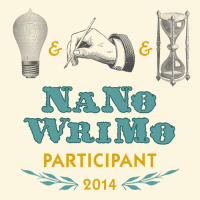 I know I blog (a little obsessively) about this twice per year, but I am still going to tell any uninitiated readers what NaNoWriMo is. NaNoWriMo is always in November (which makes October, affectionately and unofficially, NaNoPlaMo, or National Novel Planning Month). NaNo hosts a great website where authors and aspiring authors can go and register the novel that they will be working on in November. Then, each writer has from November 1-November 30 to write 50,000 words toward their goal. NaNo tracks you, sends you inspirational emails, allows other writers to connect with you, and verifies your count (which better be before midnight on the 30th, and can be slightly different from Word). They also provide widgets and a NaNo store full of tees, journals, mugs, the usual swag. Their prizes for “winning” are a little lame, but that’s not the point, at all.
I know I blog (a little obsessively) about this twice per year, but I am still going to tell any uninitiated readers what NaNoWriMo is. NaNoWriMo is always in November (which makes October, affectionately and unofficially, NaNoPlaMo, or National Novel Planning Month). NaNo hosts a great website where authors and aspiring authors can go and register the novel that they will be working on in November. Then, each writer has from November 1-November 30 to write 50,000 words toward their goal. NaNo tracks you, sends you inspirational emails, allows other writers to connect with you, and verifies your count (which better be before midnight on the 30th, and can be slightly different from Word). They also provide widgets and a NaNo store full of tees, journals, mugs, the usual swag. Their prizes for “winning” are a little lame, but that’s not the point, at all.
After Camp NaNoWriMo last April (yes, this does happen again in the summer), my husband suggested that I never do NaNo again. I am a mom, among other things, and our house and lives got ca-razy, I admit. Then again, I had half of a brand-new novel. I decided I would meet him half-way. 1) I will work on a book that I am already working on, something that is in full-swing and for which I already have an outline and a looming deadline. 2) I will not sweat falling behind on my word count in favor of sending the kids to school with clean clothes and food in their lunch pails. That’s half-way, isn’t it?
So, in celebration of the looming NaNoWriMo, I want to share four of the things I love most about it.
NaNo encourages authors and aspiring writers to write. And to be in community. Writing can be an extremely solitary job, so imposed deadlines are handy dandy. Also, so many people are out there sitting on a book idea, but no one is saying to them, “Now is the time.” NaNo does that.
 I. Love. The. Graphs. I am sure I have shared this before. It is so nice to watch as you eke up the graph each day. And it’s really helpful to know, on any given day, what you need to average to “win” your goal. I wish I had more graphs in my writing life. To be honest, I wasn’t even sure, when I started this over a year ago, that I could write 50,000 words in one month. I am not, really, a fast writer, partly because I am a careful and thoughtful writer. (We all have different styles of first-drafting it.) I thought that perhaps I was going to have to pull out the old typewriter in order to hit 50,000 in a month, so that I could not edit as I went. I was shocked, then, when I pulled out a day at 3000 words… then 4000 words… then 5000 words! It made me more aware of my capabilities (and my need for stamina, as I had to buy a mic, install voice-to-text software, and ice my hands for 48 hours).
I. Love. The. Graphs. I am sure I have shared this before. It is so nice to watch as you eke up the graph each day. And it’s really helpful to know, on any given day, what you need to average to “win” your goal. I wish I had more graphs in my writing life. To be honest, I wasn’t even sure, when I started this over a year ago, that I could write 50,000 words in one month. I am not, really, a fast writer, partly because I am a careful and thoughtful writer. (We all have different styles of first-drafting it.) I thought that perhaps I was going to have to pull out the old typewriter in order to hit 50,000 in a month, so that I could not edit as I went. I was shocked, then, when I pulled out a day at 3000 words… then 4000 words… then 5000 words! It made me more aware of my capabilities (and my need for stamina, as I had to buy a mic, install voice-to-text software, and ice my hands for 48 hours).
 I also love all the words that are on the page at the end of NaNo, regardless of whether or not I actually hit 50-grand. Last November, I threw my back out and had difficulty typing while flat on my back and highly medicated. I still hit something like 35,000 and went on to finish the short novel in the next two months. Before November, I had 0 words on The Night of One Hundred Thieves. Now, it is in its final edits and very close to publication. See? The words are great.
I also love all the words that are on the page at the end of NaNo, regardless of whether or not I actually hit 50-grand. Last November, I threw my back out and had difficulty typing while flat on my back and highly medicated. I still hit something like 35,000 and went on to finish the short novel in the next two months. Before November, I had 0 words on The Night of One Hundred Thieves. Now, it is in its final edits and very close to publication. See? The words are great.
Write Ins!!! This is perhaps the best thing about NaNo, but it’s not strictly a NaNo thing, nor does every location offer them. A Write In is just a group of writers getting together to sit and write. You don’t even really talk, usually. You drink coffee (or in my case, an OJ and club soda) and stare at your laptops in some sort of snooty environment. Love it! It’s what I always thought writing would be like.
So, do you have a book waiting to burst forth from your creative mind? Want to tackle that 50,000 word goal? (If you want to start lower, consider Camp NaNoWriMo in April or July, when you can tailor your goal.) I suppose it doesn’t even have to be a novel, right? A memoir. Something non-fictiony you know a whole lot about. You still have a couple weeks to plan (and I do strongly suggest you plan).
Then, when the moon rises over your Halloween midnight, gather in that fresh stockpile of candy and tap out those first, brilliant words. They are just the first of many.


October 7, 2014
Best Books List: Memoir and Autobiography
Making that Best Books List for Comedy a few weeks back really made me wonder why I didn’t include comedy on my Best Books List. Then I wondered why I didn’t include memoir, history, travel, nonfiction, food, journalism, graphic novels, YA, and literary. Besides (already included) philosophy and religion, these are all things I love to read. But I like to read the best of them. There is a lot of overlap on these lists, and they tend to be a but myopic; perhaps in the future I’ll have to add a best of indie or best of self-published. Until then, I am going to do a series on more best books list, by subject.
And no, I didn’t come up with these. I just put them together by comparing best books genre lists from the more reliable sources I could find. In no particular order, this week, it’s…
Memiors and Autobiography (with a little Biography)
Tuesdays With Morrie, Mitch Albom

Reading Lolita in Tehran, Azar Nafisi
Angela’s Ashes, Frank McCourt (read this awhile ago. Maybe four stars?)
A Long Way Gone, Ishmael Beah (One of the last things I read before starting the Best Books list. Again, maybe four stars.)
Running With Scissors, Augusten Burroughs (also on the comedy list)
Born Standing Up, Steve Martin (also on the comedy list)
The Glass Castle, Jeanette Walls
Night, Elie Wiesel (How many times has this been recommended to me?)
 Speak, Memory, Vladamir Nobokov
Speak, Memory, Vladamir NobokovThe Liars Club, Mary Karr
Maus, Art Spiegelman
The Woman Warrior, Maxine Hong Kingston
Darkness Visible, William Stryon
This Boy’s Life, Tobias Wolf
Lives of the Ceasars, Seutonius
Experience, Martin Amis
A Moveable Feast, Ernest Hemingway
The Life of Samuel Johnson, James Boswell
 Eminent Victorians, Lytton Stratchey
Eminent Victorians, Lytton StratcheyGoodbye to All That, Robert Graves
The Moon’s a Balloon, David Niven
Rings of Saturn, W. G. Sebald
The Diaries of Samuel Pepys, Samuel Pepys (I have wanted to read these forever)
De Profundis, Oscar Wilde
Alan Clark: Diaries, Alan Clark
The Autobiography of Alice B. Toklas, Gertrude Stein
Seven Pillars of Wisdom, T. E. Lawrence
Testament of Youth, Vera Brittain
 My Family and Other Animals, Gerald Durrell
My Family and Other Animals, Gerald DurrellHomage to Catalonia, George Orwell
The Diary of a Young Girl, Anne Frank (read a long time ago)
I Know Why the Caged Bird Sings, Maya Angelou (read in highschool)
Wild Swans, Jung Chang
Lives of the Most Excellent Painters, Sculptors, and Architects, Giorgio Vasari
Walden, Henry David Thoreau
The Life of Charlotte Bronte, Elizabeth Gaskell (so going to read this ASAP)
Out of Africa, Karen Blixen
 The Year of Magical Thinking, Joan Didion
The Year of Magical Thinking, Joan DidionA Heartbreaking Work of Staggering Genius, Dave Eggers
Persepolis, Marjane Satrapi (saw the movie)
Amazing Grace, Eric Metaxas
What do you think? Good list? You read any? It is the shortest list, for some reason. You have any additions?


October 2, 2014
Writers Is Writers
Recently I witnessed a most miraculous transformation, as a self-proclaimed political poet showed up to a local reading group and read what was his “first attempt” at a short story. It was so decent (read: better than decent) that I was further in awe when he shared offhandedly that it was completely not autobiographical. Besides complementing this man in a roundabout way, I use this experience to segue-way into an interview with a musician.
Makes perfect sense, right?
 The truth is, what I really want to do is introduce you to Durham artist David B. Dollar’s music. And tell you he has a new EP, which was released this week. What I don’t want to do is plug the new music without giving you what The Starving Artist consistently brings you: blogs about writing, reading, and publishing. Period. So we’re going to make this interesting and more than relevant.
The truth is, what I really want to do is introduce you to Durham artist David B. Dollar’s music. And tell you he has a new EP, which was released this week. What I don’t want to do is plug the new music without giving you what The Starving Artist consistently brings you: blogs about writing, reading, and publishing. Period. So we’re going to make this interesting and more than relevant.
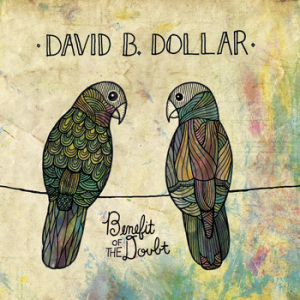 After all, Dollar is a writer. He’s a song-writer (which is one of the things, in my opinion, he does best, as an artist). I rarely if ever have noticed a bridge of communication between writers and song writers. But we’re all artists here, right? Writers are often lumped together in teachings, in conferences, in fairs… from playwrights to poets, novelists to essayists. Why not song writers? Can it be that different of a process, just because they also focus on manipulating auditory material? And aren’t they in a very similar boat with the advent of digital production and indie-producers? Sounds a lot like e-books and self publishing to me.
After all, Dollar is a writer. He’s a song-writer (which is one of the things, in my opinion, he does best, as an artist). I rarely if ever have noticed a bridge of communication between writers and song writers. But we’re all artists here, right? Writers are often lumped together in teachings, in conferences, in fairs… from playwrights to poets, novelists to essayists. Why not song writers? Can it be that different of a process, just because they also focus on manipulating auditory material? And aren’t they in a very similar boat with the advent of digital production and indie-producers? Sounds a lot like e-books and self publishing to me.
Which is further underlined whenever I have talked to Dollar, casually, about our lives as artists. All of a sudden, I am talking to someone who is having a similar experience, who has the same challenges and victories, and who understands my career. And hobby. And basically me. In fact, I would go so far as to say I have even had very interesting, enlightening, and conspiratorial conversations with artists in general: musicians, painters, crafters, potters, photographers, ballet dancers, whatever. Not that we are going to embrace all artists here on The Starting Artist (j/k). But we’re all artisans. And we have shared experiences in an ever-shifting, modern world of providing art to the masses.
Plus, the first and last songs of the album are called “Inlet” and “Outlet.” What’s more poetic than that?
And if that isn’t enough reason, writing and music are often linked. Writers can be very particular about what they hear while writing. They might identify certain songs with what they are writing. Or become inspired by music. There’s even a blog all about writers and their music (The Undercover Soundtrack). I guest blogged there in 2013, and also posted a playlist for Benevolent, here.
So here’s to writing! To living the writing life, whatever kind of writer you are! And to artistic personalities!
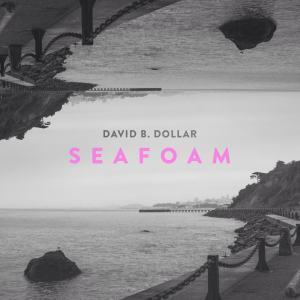 And to David B. Dollar and his new EP, Seafoam, which you really, really oughta’ check out.
And to David B. Dollar and his new EP, Seafoam, which you really, really oughta’ check out.
Handing the mic over to Dollar…
How did you get started as a musician? What are you up to now? I got started early because I grew up in very musical environment. My dad put out a tape when I was five or six. He was always playing Beatles’ records and Bob Dylan.
I just released my second record. It’s called Seafoam – www.davidbdollar.bandcamp.com. Super stoked. I think I grew a ton as a songwriter from my first to second project.
How did you get started with songwriting? When I was ten or eleven, one of my first songs was about sheep. I also remember picking up the dictionary and looking for words that I thought sounded cool for song titles. One of the words I found was tenement, which is a crappy apartment, so I wrote about a crappy apartment. At the time, I was plucking only a few chords on the guitar so the arrangements were super simple, as were the lyrics. It was all pretty rudimentary.
Have you done any other writing? How would you compare the two? I do quite a bit of journaling to metabolize my thoughts and feelings and sometimes it can be as cathartic as songwriting. I try to tap into my subconscious a little more with songwriting.
Do you know any fiction writers? How would you compare your process to theirs? I do know a few writers but I don’t know much about their processes. It’d be a great convo to have.
How is the digital revolution affecting you as a song writer? As a song producer? Wow, it’s changed everything. I can’t imagine having this much control over releasing music twenty years ago, especially with it being so accessible. I already self-produced two records using some great tools to help me distribute. It’s awesome. Sometimes I need to disconnect from technology when I’m writing, even though it can be a great tool.
Are you “self-published?” Love it? Hate it? How would you change your experience? I am. I don’t really have anything to compare it to at the moment but I like having control.
What do you write about? Where do you get your inspiration? I tend to get existential from time to time when I write, but sometimes it’s just good ol’ fashion heartbreak. I always come back to God too.
Do you go through an editing process? How does that work? Yep. I try to have a loving relationship between the lyrics and the music so sometimes things have to bend and change. Also, it’s not just the content for me, it’s the sound of the words being sung.
How do you know a song is ready for production? Do you continue to change it afterwards? It takes me forever to be satisfied. Well, not always, but usually. I do a lot of pre-production on my own so it saves time in the studio but, at least this last time, it still may change in the studio, and even in post-production. Digital makes it easy to manipulate, as we discussed earlier.




